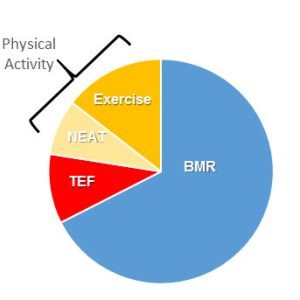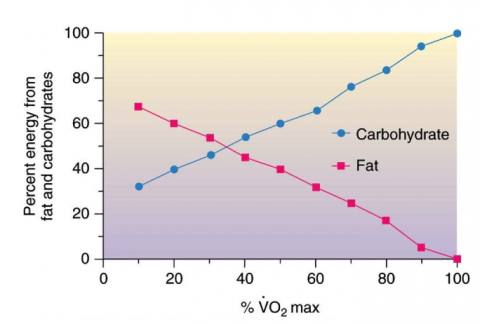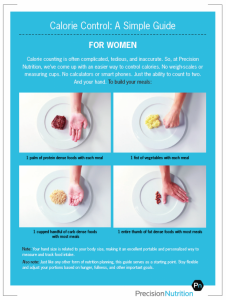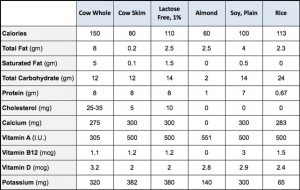Weight loss is an interesting topic these days. For some, bringing up the topics of keto, intermittent fasting, plant-based or some other popular nutritional topic of the day leads to heated discussions. Unfortunately, some conversations are prefaced with 'I believe...' and then whatever nutritional opinion follows. Emotions can become so strong with nutrition that facts and evidence get thrown out the window. And positions can be maintained as though defending a religious perspective. When discussing weight loss there are two predominant positions popping up on social media. One supposes that creating a caloric deficit is all that matters. You can eat fast food every day as long as you are eating fewer calories than you burn in a day. This ignores what the other position claims is vital, which is the quality of the nutrition. Maybe you've heard the expression 'as long as it fits your macros' to justify eating certain foods. By macros we're referring to the macronutrients i.e. proteins, carbs and fats. The truth is that both sides are correct. It matters how much you eat. A caloric deficit is needed to achieve weight loss. And the quality of the matters as well. You cannot achieve healthy weight loss with low quality nutrition.. But there's one more piece to the puzzle that typically tends to get ignored. And that's the timing of our nutrition. In other words, would you expect eating the same foods in the same amounts at different times to have an impact on our weight loss efforts? For example, if you ate a 2070 calorie breakfast, a 600 calorie lunch and a 330 calorie dinner... Would this have any difference on our fat loss efforts than if we ate the following: 330 calorie breakfast, 600 calorie lunch, 2070 calorie dinner. The answer is that it does...
Nutrition Cheat Sheet
- Chris Collins
- Fitness
- 2548 Hits
- 0 Comments
-
Nutrition is one area of fitness and performance that many struggle with. Take for example the recent documentary Game Changers as an example. Since this film has begun to trend we're hearing of more and more people making the switch to becoming vegan or vegetarian. What this tells me is that the average person: A. Can be easily swayed by a Hollywood story i.e. James Cameron, Arnold Schwarzenegger and Jackie Chan produced and/or directed this documentary. B. Is seeking more or better results and is willing to make changes to achieve better results. Knowing that many don't have a background in nutritional science and want to achieve the best results was the inspiration for this piece. Oftentimes those seeking the best results may invest in a supplement and so we want to provide some direction on that end as well. As we evaluate the various aspects of nutrition we want to identify if there would be benefit to adding a supplement to the mix. We need to be on the same page as to what is a supplement and here is our criteria. Something that is in addition to and not in place of.Something that is morally and legally justified.Something that has 3rd party labeling to assure the quality. If a substance doesn't adhere to these three rules we, the coaches at Okanagan Peak Performance Inc., would not recommend it to our clients. Obviously it is possible to source many products that don't satisfy these three rules, and find coaches that may recommend them, but these are our rules. Now onto the nutritional guidelines. Step 1 - Energy Balance The first step is to determine is you are eating enough calories to support your goal. The last part of the sentence is key. If we want to change our mass we...
Sleep, Cravings and High Calorie Foods
- Chris Collins
- Fitness
- 1760 Hits
- 0 Comments
-
There are a few goals we have for everyone we work with. It doesn't matter if the individual's goal is performance, weight loss or rehab we look to achieve this with all of them?Do you know what 'it' is?What we're looking to achieve with all these clients is help them be as lean as possible. And here's why.For a movement, non-collision sport athlete one of the goals is to generate as much strength and power per unit of body weight. In cycling, the unit of interest is watts/kilo. And to improve is to increase our power, decrease our mass or both. Sometimes an athlete has maxed out on the power they can produce but they are carrying a few extra pounds. Leaning up a little bit can be the difference to increased performance.Obviously for the weight loss client we want to shed as much unnecessary mass as possible while keeping as much muscle as possible.And for the rehab client a leaner physique helps in a number of ways. A leaner indivudual can move better than an overweight one. They will have more energy to do more. And a leaner frame takes stress on load-bearing joints. With the knees for example, every pound that is shed takes four pounds off the knees.With my own training and goals I'm looking to be as lean and strong as possible. With the fondo coming up in a little over a week all the hard training should be done or wrapping up soon. And now it's just a matter of dialing in the nutrition and resting up.Obviously a lighter bike helps, especially when climbing hills. But instead of looking to save grams by upgrading seat posts, wheels and bottle cage holders, it would make more sense to shed pounds on the scale.For example, going from an...
11 Ways to Get Lean - That Don't Require Extra Time or Money
- Chris Collins
- Fitness
- 1984 Hits
- 0 Comments
-
A couple of things I really like are efficiency and great value. I like it when things are moving forward at a good clip and when the return is better than expected. Who doesn't like that though, right?This is no different than our health and fitness. For most the obstacle to better health and fitness comes down to time and finances. We don't make the time for fitness and exercise and we would rather spend our money on other things.The truth is that the fittest people in the world have the same hours as the rest of us. It's what we give our time to, or don't, that fills up our day.So with that being said I wanted to give you 11 tips to get lean. And the cool part is these things won't cost you an extra dime. Plus as your health improves you'll find you have more time in your day. You see what I did just there, right? Solve one problem and provide a solution for another as well.Anyways on with the tips. Minimize liquid calories - If our goal is to be as lean and healthy as possible we've got to be mindful of the calories we drink. This can be a chai tea in the AM, a coffee with cream and sugar, a store bought smoothie or any of the other ways we can drink calories. The truth is we only need water. Sure a red wine on occasion or a beer at a BBQ isn't going to derail your results completely. Just be aware of what you are drinking. And guess what? When we cut back on your liquid calories we'll find you have an extra $5-10 per day by opting out of the drive-thrus and coffee shops. Eat meals without snacking - Were you ever...
Are BLTs Sabotaging Your Results?
- Chris Collins
- Fitness
- 1645 Hits
- 0 Comments
-
At Okanagan Peak Performance Inc we work with a variety of clientele that want to look, feel or play better. And these are quite varied goals. But one thing is in common with these three groups.And that's the goal of getting lean.Sure we get the occasional male teen that is looking to increase his mass. But he wants to get bigger through the chest, arms, legs and back and not necessarily bigger at the waist. As one young male client put it 'I want to look more like Captain America'.Getting lean is important for the aesthetic population as this helps them feel better. They have more confidence going to the beach and wearing less clothing. It helps motivate them to do more in their training and spills over to other areas of their lives.For athletes, being lean improves their relative strength and power. In other words if they can produce the same force at a lighter weight this will be an advantage in competition. Imagine an athlete sprinting with a piano strapped to their back and with the piano removed. Obviously dropping mass that doesn't help will be an advantage.And for the group that wants to feel better getting lean is helpful as well. This is important for all the weight bearing joints and the effect it can have on our posture. With our knees every extra pound of body weight is equivalent to four extra pounds of pressure on the knees. Getting lean is one of the best things an individual can do to reduce knee pain.So if we can agree that getting lean is important and applies for everyone from those wanting to look, feel and play better, than why can it be so hard?Well one of the reasons might be BLTs. And I don't mean sandwiches. Instead I'm...
How much, what and when to eat
- Chris Collins
- Fitness
- 1897 Hits
- 0 Comments
-
Nutrition is an interesting topic. For some, they treat it like religion. But it isn't like religion at all. It doesn't matter what I believe. Instead what should matter is what the research tells us to be true. We can decide to accept science or not.Only once we move beyond the idea of nutrition as a belief system can we address any of the questions we may have with the foods we eat.And there's a particular order, or hierarchy, of how to address our nutrition. This concept was proposed by Tom Venuto and works quite well.Before we get to addressing the layers of this hierarchy of this concept we need to understand the context of the situation. For this blog we are writing with the end goal being fat loss. The prescription would differ for someone with a performance goal or looking to add lean mass.The first place to start is to answer the question 'how much should we eat?' If we get this part wrong it's a lot harder to achieve our goal and can add frustration to positive efforts.In order to determine your daily caloric requirement we need to know about the individual. The sex of the individual - Men require about 12-13% more calories than women. If you eat according to portion size this is 1/8th and can be used to estimate energy when plating out meals. The age of the individual - A younger person will require more than a older person. For adults our caloric requirement will decrease by about 3.8 cal/year. The individual's occupation - Someone with a desk job will require less nutrition than a very active occupation like a bike courier. The individual's activity - Not counting work-related tasks it helps to know if the person moves a lot or not.And as we mentioned this...
What type of milk to drink
- Chris Collins
- Fitness
- Nutrition Advice
- 1882 Hits
- 0 Comments
-
Do you drink milk? That's a pretty easy question because it doesn't specify what kind of milk? Most people assume you mean cow's milk but nowadays that question can be open to interpretation as the regular variety or one of rice, almond or soy. So what's the difference between the different types of milk? And more importantly is there one type that you should be drinking? Below is a table that summarizes the key nutritional differences between the various types of milk. Let's take a look at each. [caption id="attachment_3527" align="alignleft" width="300"] Nutritional data of different kinds of milk Almond MilkThis is made by crushing almonds with water and as it is not produced with animal products it has little to no saturated fat or cholesterol. Compared to cow's milk it has as little as 40% of the calories and does not contain the sugar lactose. However when drinking almond milk you lose much of the protein, calcium and vitamin B12 found in cow's milk. Soy MilkThis milk is made with soybeans and water and is also produced without animal products therefore is has little saturated fat and no cholesterol. In terms of calories it is comparable to some forms of cow's milk and is almost double the energy of almond milk. In terms of the protein content soy has slightly less than cow's milk and is comparable in terms of the vitamin and mineral content. Rice MilkAny guesses how rice milk is produced? As with the other two varieties it is made by combining rice (usually brown) with water. Since this form of milk is made from a starch it has a higher carbohydrate content and the highest calorie content of non-dairy types of milk. Again as with the other 2 non-dairy varieties this is a non-animal form of milk so the...
5 Drinks to Get Familiar With
- Chris Collins
- Nutrition Advice
- 1793 Hits
- 10 Comments
-
So the #1 goal of people who go to the gym is weight loss. And it's like finger nails on a chalk board when I see people making all the right decisions when it comes to training, rest and the foods they eat only to blow it in one area. What is that one area? It's the calories they drink. They will drink coffees with flavoured shots, artificial sweeteners, creams and other additives. They will puree enough fruit for two days and drink this. Worse they will buy the commercial varieties of the juice smoothies which often have well over 100 grams of sugar. They will finish off a hard day's work with a glass or two of their favourite beer or wine. Which normally isn't a problem except when you're trying to drop 20-30 lbs. And so for these people we make the rules very simple. 1. Get all of your nutrition from food. 2. Get your hydration from water. But there are exceptions to the rule. And this post is all about those exceptions. Because at a certain point you should gain control of the calories you drink back. And your water intake should be adequate. And you should be getting all your nutrition from food. And your weight loss should be on track. And if this the case read on to find out how you can begin to reintroduce drinks back into your like. If this is you then here are 5 drinks you can reintroduce back into your lifestyle. 1. Workout Drinks - Are your workouts at least an hour in length? Are workouts fairly intense? By this I mean that you broke a sweat, lifted as heavily as you could and were out of breath at various points during the workout. If you answered 'yes' to...
5 Tips for Better Step-Ups
- Chris Collins
- Training
- 1929 Hits
- 1 Comment
-
Today we're celebrating Thanksgiving weekend in Canada. So with the indulgence in turkey, gravy, potatoes and of course some pumpkin pie the mind tends to shift towards thinking about ways to burn all these extra calories. Plus as the seasons change our activities move from links and lakes to the hills for winter fun.So with this in mind I usually like to incorporate more step-ups in the workout. Step-ups are great in that they work well for all levels, they allow you to get in some quality single leg work and with a few changes in the acute variables of sets, reps and rest you can train for a variety of different purposes.But before you jump in and start with the step-ups there are 5 technique points that will help you perform this lift more safely and effectively.1. Maintain a neutral foot. Many of us tend to roll into pronation when we bend at the ankle-knee-hip. Imagine your foot collapsing towards the arch when you take a step. If this happens you will disrupt the chain reaction that occurs with ground based motion and have altered mechanics as you step up. Keep a neutral foot and watch that the knee is in line with the 2nd/3rd toes.2. Paw the bench. With the foot that is on the bench imagine pulling the bench towards yourself. This loads up the glutes and hamstrings which many of us have difficulty recruiting during our leg training. 3. Take a larger step. This ties in with the previous point of trying to engage the posterior chain. Many of us are quad dominant and look to use our quads first and glutes and hamstrings, second, if at all. With a larger step you open up the angle at the knee and hip which takes load off the...




